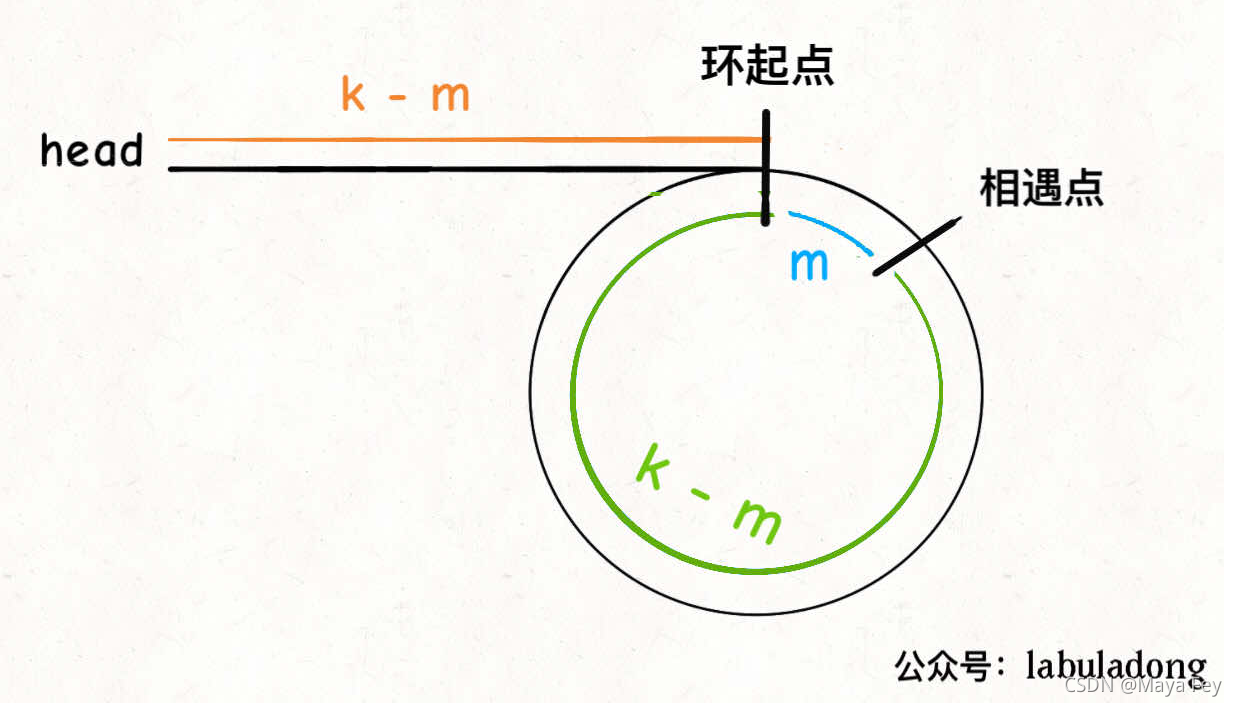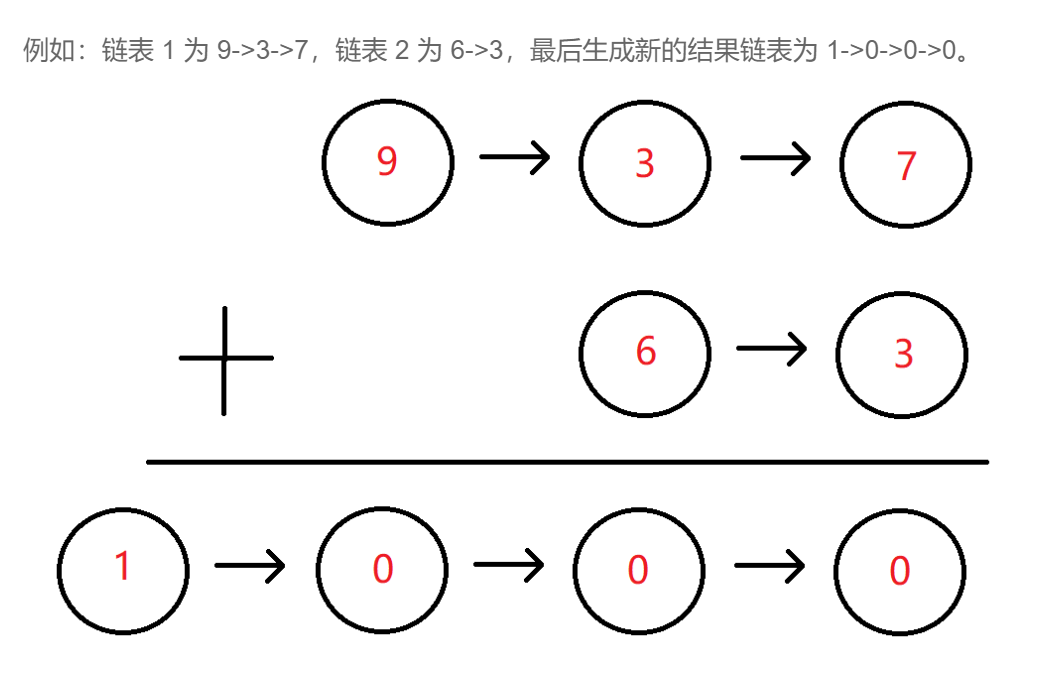准备重启尘封一年的博客作为学习笔记,看看自己能坚持多久。
最近会记录做过的算法题,语言描述只用于会意,仅供参考。
文章目录
- 0.从尾到头获取链表的值(不是反转链表)
- 1.寻找/删除单链表倒数第k个节点
- 3.寻找单链表的中点
- 4.判断链表是否成环 / 求成环链表的起点
- 5.判断两个链表是否相交
- 6.反转整个链表
- 迭代法
- 递归法**
- 7.反转链表的从第left到第right个节点
- 迭代法
- 递归法
- 8.K个一组反转列表
- 9.判断回文链表
- 10.复制复杂的链表
- 11 链表加法
0.从尾到头获取链表的值(不是反转链表)
解答思路
- 最直观的想法是,遍历链表求出长度,创建空数组,再遍历链表将每个节点的值反向填进数组
- 递归解法很简洁,思路类似于树的后根遍历(先根->递归过程自顶向下,后根->递归过程自底向上),从想象一棵单叉的树(其实就是链表),叶节点向根节点前进,就能得到反向的顺序
# -*- coding:utf-8 -*-
# class ListNode:
# def __init__(self, x):
# self.val = x
# self.next = Noneclass Solution:# 返回从尾部到头部的列表值序列,例如[1,2,3]def printListFromTailToHead(self, listNode):if listNode is None:return []return self.printListFromTailToHead(listNode.next) + [listNode.val]
1.寻找/删除单链表倒数第k个节点
- 使用两个指针(forward backward),起始时都指向头节点,首先让forward指针向前k步,到达第k+1个节点,然后让两指针以相同速度前进,直到forward为None,此时的backward指向的就是倒数第k个节点。
- 对于删除问题,需要额外引入一个指针,指向backward之前的节点。此时会出现特殊情况:如果倒数第k个节点是链表的头节点,则需要特殊处理。
/*** Definition for singly-linked list.* public class ListNode {* int val;* ListNode next;* ListNode() {}* ListNode(int val) { this.val = val; }* ListNode(int val, ListNode next) { this.val = val; this.next = next; }* }*/
class Solution {public ListNode removeNthFromEnd(ListNode head, int n) {// 特判if (head.next == null && n == 1) {return null;}ListNode a = head;ListNode b = head;ListNode pre_b = null;// 先走afor (int i=0; i<n; i++) {a = a.next;}// ab同时走,直到a到达末尾while (a != null) {pre_b = b;a = a.next;b = b.next;}// 得到b是待删除结点// 如果b是首个元素,返回b.nextif (pre_b == null) {return b.next;}// b非首个元素pre_b.next = b.next;return head;}
}
3.寻找单链表的中点
- 使用快慢指针法。每次步进fast走两步,slow走一步,当fast或fast.next指向None时,slow即为中点。如果链表长度为偶数,则slow指向中间并靠后的节点
- 注意循环判断条件
fast != null && fast.next != null
/*** Definition for singly-linked list.* public class ListNode {* int val;* ListNode next;* ListNode() {}* ListNode(int val) { this.val = val; }* ListNode(int val, ListNode next) { this.val = val; this.next = next; }* }*/
class Solution {public ListNode middleNode(ListNode head) {ListNode slow = head;ListNode fast = head;while (fast != null && fast.next != null) { // 注意判断条件slow = slow.next;fast = fast.next.next;}return slow;}
}
4.判断链表是否成环 / 求成环链表的起点
- 快慢指针。如果fast最终能遇见None,则不成环。如果slow最终能遇见fast,则成环。
/*** Definition for singly-linked list.* class ListNode {* int val;* ListNode next;* ListNode(int x) {* val = x;* next = null;* }* }*/
public class Solution {public boolean hasCycle(ListNode head) {ListNode fast = head;ListNode slow = head;while (fast != null && fast.next != null) {slow = slow.next;fast = fast.next.next;if (fast == slow) {return true;}}return false;}
}
要求成环链表的起点,需要在fast和slow相遇时,将一个指针指向链表头,再让两指针以1步长前进直到相遇,相遇点即为环起点。
假设首次相遇时,fast比slow多走了k步,则这k步一定是在环内绕圈,即k是环长度的整数倍。此时让一个指针回到头节点,共同前进k-m步后一定会在环起点相遇。

/*** Definition for singly-linked list.* class ListNode {* int val;* ListNode next;* ListNode(int x) {* val = x;* next = null;* }* }*/
public class Solution {public ListNode detectCycle(ListNode head) {ListNode fast = head;ListNode slow = head;while (fast != null && fast.next != null) {slow = slow.next;fast = fast.next;if (fast != null) {fast = fast.next;}// 有环if (fast == slow) {fast = head;} else {continue;}while (fast != slow) {fast = fast.next;slow = slow.next;}return fast;}// 无环return null;}
}
5.判断两个链表是否相交
- 关键在于解决两个链表的对齐问题。解决办法是,将链表A的末尾指向链表B的头节点,同理B的末尾指向A的头节点。使用两个指针a、b分别从A和B的头节点开始步进,直到遇见相同节点。
- 直观思路:
对于a,走过A的独有部分->相交部分->B的独有部分->相交部分
对于b,走过B的独有部分->相交部分->A的独有部分->相交部分 - 如果两个链表不相交,则 pa 和 pb 在对方末尾的 None 相等,返回 None
class Solution(object):def getIntersectionNode(self, headA, headB):""":type head1, head1: ListNode:rtype: ListNode"""pa = headApb = headBwhile (pa != pb):pa = pa.next if pa is not None else headBpb = pb.next if pb is not None else headAreturn pa
6.反转整个链表
迭代法
对于每个节点分为三个步骤:
temp = node.next // 记录当前节点的下个节点,防止修改后找不到
node.next = pre // 反转
pre = node // 步进
node = temp // 步进
/*** Definition for singly-linked list.* public class ListNode {* int val;* ListNode next;* ListNode() {}* ListNode(int val) { this.val = val; }* ListNode(int val, ListNode next) { this.val = val; this.next = next; }* }*/
class Solution {public ListNode reverseList(ListNode head) {// 迭代ListNode temp = head; // 从head开始处理,head.next最后指向nullListNode pre_temp = null;while (temp != null) {ListNode next_node = temp.next; // 保存temp.next = pre_temp; // 更改指针pre_temp = temp; // 步进temp = next_node;}return pre_temp;}
}
递归法**
- 来自拉不拉东的算法小抄:写递归算法的关键是,明确函数的定义是什么,“相信定义”,用其推导出最终结果,而不陷入递归的细节。搞清楚根节点该做什么,剩下的交给前中后序遍历
- 写递归时要有遍历树的思想。下面的代码即为树的后根遍历
- 反转等操作(类似题1)都能用后根的思想解决
# Definition for singly-linked list.
# class ListNode(object):
# def __init__(self, val=0, next=None):
# self.val = val
# self.next = next
class Solution(object):def reverseList(self, head):""":type head: ListNode:rtype: ListNode"""# 递归出口if head is None or head.next is None:return headreversed = self.reverseList(head.next)head.next.next = headhead.next = Nonereturn reversed
7.反转链表的从第left到第right个节点
迭代法
- 首先定位到第left个节点,记录边界,并执行right-left次反转
# Definition for singly-linked list.
# class ListNode(object):
# def __init__(self, val=0, next=None):
# self.val = val
# self.next = next
class Solution(object):def reverseBetween(self, head, left, right):""":type head: ListNode:type left: int:type right: int:rtype: ListNode"""dummy = ListNode(val=-1, next=head)pre_node = dummytemp_node = head# 移动到第left个节点for i in range(left-1):pre_node = temp_nodetemp_node = temp_node.next# 记录左侧未被反转的最后一个节点,和被反转的第一个节点forward_last_node = pre_nodereverse_first_node = temp_node# 从开始反转的第二个节点开始,改变连接关系pre_node = pre_node.nexttemp_node = temp_node.next# 执行反转for i in range(right-left):temp = temp_node.nexttemp_node.next = pre_nodepre_node = temp_nodetemp_node = temp# 连接reverse_first_node.next = temp_nodeforward_last_node.next = pre_nodereturn dummy.next
递归法
首先写一个反转头部前N个节点的函数reverseN
ListNode reverseBetween(ListNode head, int m, int n) {// 递归出口if (m == 1) {return reverseN(head, n);}head.next = reverseBetween(head.next, m - 1, n - 1);return head;
}
8.K个一组反转列表
class Solution:def reverseKGroup(self , head , k ):# write code hereif not head or k == 1:return headdummy = ListNode(-1)node = head last_left = None while (self.enough(node, k)): # 每次反转k个pre = node cur = node.next# 执行反转for _ in range(k - 1):temp = cur.nextcur.next = pre pre = cur cur = temp if node == head: # 记录返回结果dummy.next = pre # 处理边界if last_left:last_left.next = pre last_left = node node = cur if last_left: # 连接最后不到k个不反转的last_left.next = node return dummy.next if last_left else head # 判断从当前节点开始是否够k个def enough(self, node, k):cnt = 0while node:node = node.nextcnt += 1if cnt >= k:return True return False
就这么做!
class Solution {public ListNode reverseKGroup(ListNode head, int k) {ListNode prevLeftNode = null; // 记录上一组反转后的最后节点ListNode res = null; // 记录结果ListNode prev = head;ListNode curr = head.next;while (this.hasKNodesLeft(prev, k)) {ListNode groupHead = prev; // 记录当前组反转前的首个节点// 组内反转k-1次for (int i = 0; i < k - 1; i++) {ListNode temp = curr.next;curr.next = prev;prev = curr;curr = temp;}// 更改和前一组的指针if (prevLeftNode != null) {prevLeftNode.next = prev; // 非第一组,改变指向} else {res = prev; // 第一组,记录结果}// 更改循环条件prevLeftNode = groupHead;prevLeftNode.next = curr; // 先把上一组的最后值指向下一组(可能不够k个)的首个位置,如果够k个再修改prev = curr;curr = curr == null ? null : curr.next; // 避免下一组无元素}return res;}/* 判断是否足够k个节点 */public boolean hasKNodesLeft(ListNode node, int k) {int count = 0;while (node != null && count < k) {count += 1;node = node.next;}return count == k ? true : false;}
}
9.判断回文链表
方法一,使用递归,使用树的后根遍历思想,实现栈“后进先出”的功能。
// 左侧指针
ListNode left;boolean isPalindrome(ListNode head) {left = head;return traverse(head);
}boolean traverse(ListNode right) {if (right == null) return true;boolean res = traverse(right.next);// 后序遍历res = res && (right.val == left.val);left = left.next;return res;
}
方法二,利用快慢指针寻找中点,反转中点以后的链表并进行比较,推荐
class Solution(object):def isPalindrome(self , head ):if not head:return True slow, fast = head, head while (fast):slow = slow.next fast = fast.next if fast:fast = fast.next # 反转后半部分post = self.reverse(slow) # 逐个比较pre = head while (pre and post):if pre.val != post.val:return False pre = pre.next post = post.next return True def reverse(self, node):if not node:return Noneelif not node.next:return node r = self.reverse(node.next)node.next.next = node node.next = None return r
10.复制复杂的链表
链表的每个节点都具有val, next, random属性。关键点是random如何获取——下标如何获取——借用list / 哈希表
"""
class Solution:# 返回 RandomListNodedef Clone(self, pHead):if not pHead:return pHead dummy = RandomListNode(-1)head = RandomListNode(pHead.label)dummy.next = head # 先复制原链表,用两个数组分别记录新老链表的节点olist = [pHead]nlist = [head]p = pHead.next while (p):head.next = RandomListNode(p.label)head = head.next nlist.append(head)olist.append(p)p = p.next # 连接randomfor i in range(len(olist)):target = olist[i].random if not target:continue idx = olist.index(target)nlist[i].random = nlist[idx]return dummy.next
更优的解法
class Solution {public Node copyRandomList(Node head) {if (head == null) {return null;}List<Node> nodes = new ArrayList<>(); // 存放复制的节点Map<Node, Integer> mapping = new HashMap<>(); // 用哈希表记录节点到下标的映射// 复制值,并记录下标Node node = head;int index = 0;while (node != null) {nodes.add(new Node(node.val));mapping.put(node, index);index++;node = node.next;}// 执行连接node = head;for (int i = 0; i < nodes.size(); i++) {// 1.连接randomNode temp = nodes.get(i);if (node.random != null) {int randomIndex = mapping.get(node.random);temp.random = nodes.get(randomIndex);}// 2.连接nextif (i < nodes.size() - 1) {temp.next = nodes.get(i + 1);}node = node.next;}return nodes.get(0);}
}
11 链表加法

- 借助栈实现后端对齐
- 处理最后一步的进位问题
class Solution:def addInList(self , head1 , head2 ):# write code here# 用栈s1, s2 = [], []while head1:s1.append(head1)head1 = head1.next while head2:s2.append(head2)head2 = head2.next post = None plus = 0while (s1 and s2):n1, n2 = s1.pop(), s2.pop()val = n1.val + n2.val + plus plus = 1 if val >= 10 else 0val -= 10 if val >= 10 else 0node = ListNode(val)node.next = post post = node if s1:while s1:n1 = s1.pop()val = n1.val + plus plus = 1 if val >= 10 else 0val -= 10 if val >= 10 else 0node = ListNode(val)node.next = post post = node elif s2:while s2:n2 = s2.pop()val = n2.val + plus plus = 1 if val >= 10 else 0val -= 10 if val >= 10 else 0node = ListNode(val)node.next = post post = nodeif plus == 1:res = ListNode(1)res.next = post return res return post
![[读书笔记] 《修炼之道:.NET 开发要点精讲》](http://pic.xiahunao.cn/[读书笔记] 《修炼之道:.NET 开发要点精讲》)








![[C#.NET 拾遗补漏]10:理解 volatile 关键字](http://pic.xiahunao.cn/[C#.NET 拾遗补漏]10:理解 volatile 关键字)









——访问修饰符正确姿势)